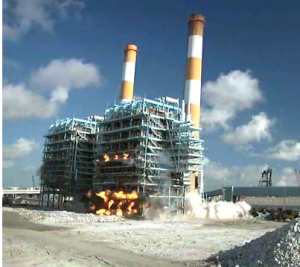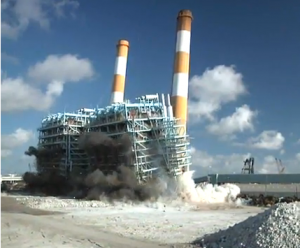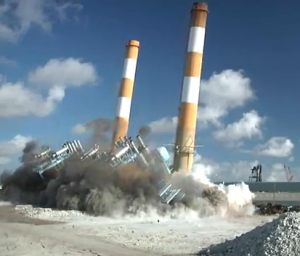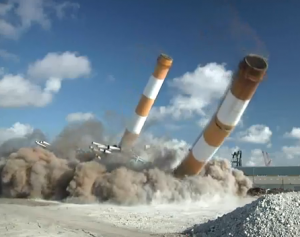Chanting, "4, 3, 2, 1." And then a PA-system,"Fire." Quick flashes, a series of booms and a delayed blast follow. (Watch in right window.) Florida Power & Light's smokestacks, boilers and water tower groan, then rumble, pitching forward, collapsing and crashing, as cheering politicians, FPL officials and locals applaud the well-executed demolition. Out in the bay, also cheering and whooping, blast-startled boaters (video) had just watched smokestacks silently arcing and slipping to the ground. Smoke and debris slowly settle into the end of an era. 18,000 tons of tangled metal would later be hauled away and recycled. Just ten months before and 135 miles away, FPL had also demolished (video) its Cape Canaveral power plant. This sums up the confluence of trends among utility executives and managers.

Aging infrastructure becoming a top concern

Black & Veatch (read press release), a global construction firm, concludes in an industry-wide survey, that for the first time aging infrastructure is the top concern among all respondents. This concern matches findings from the American Society of Civil Engineers' (ASCE) 2009 Report Card on America's Infrastructure. The ASCE gave the US energy infrastructure a D+ rating and estimated a total investment of $75 billion dollars for new or upgraded generation and transmission and distribution assets. Also, in spite of growing debate about fracking, Black & Veatch add that the demand for shale gas to generate power will increase over the next decade, overtaking wind and nuclear as the top "environmentally friendly" technology.
Florida Power & Light's new natural gas plants

The Riviera Beach modernization will begin in late 2011. Increasingly expensive to operate, the 1960s era gas-and oil-fired units will be replaced with the new advanced Siemens H-class gas turbines. When the Riviera Beach returns to service in 2014, "...FPL will be well-positioned to comply with anticipated energy legislation," said Randy Zwirn, president and CEO of Siemens Energy. "The reduction in emissions is the same as taking approximately 45,000 cars off the road annually over the life of the plant." The state-of-the-art power plant will use high-efficiency, combined-cycle natural gas technology to produce up to 1,250 megawatts of electricity, or enough power for approximately 250,000 of FPL's 4.5 million customers. Watch as the company designs and builds a similar turbine for its Berlin plant:
Siemen's new turbines significantly reduce costs and CO2 emissions
FPL is investing more than $1 billion to build the new facility. The Siemens gas turbines consume one-third less natural gas and emit one-third less CO2, while generating the same amount of power. CO2 emissions are 75% below coal-fired power plants. The gas turbine is the main drive for power generation, and to improve overall efficiency, exhaust heat from the gas turbine is used to produce steam for the generation of additional electricity by a steam turbine. Also, the turbines can go from standby to startup in five minutes and reach full power operation in only 15 minutes. They need only minutes to switch from full power to half power or vice versa, enabling them to optimally compensate for natural fluctuations in rapidly increasing grid feed-ins from wind and solar energy sources.



